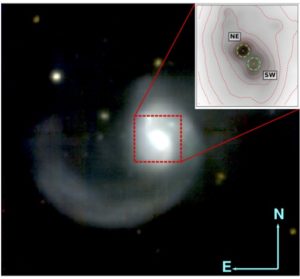Fast fade

The host galaxy of the ASASSN-14ko outburst, showing signs of a late-stage galaxy merger such as a prominent tidal arm toward the lower left. The center of the galaxy, shown in the inset, reveals a second, fainter nucleus to the southwest. (Image: Michael Tucker.)
To the casual observer, the night sky is a rarely changing panorama.
To Michael Tucker and his colleagues, it’s an evolving system, with bodies that suddenly appear each night, then brighten and fade.
Tucker, a University of Hawaii astronomy doctoral candidate, concentrates on what researchers in his field call transients: fleeting celestial events, especially supernovae – exploding stars – and flares. These provide a glimpse into astrophysical processes governing black holes, the creation of heavy elements and more. But scientists must observe the objects quickly, before they disappear.
Tucker, a Department of Energy Computational Science Graduate Fellowship (DOE CSGF) recipient, finds transients via sky surveys, particularly the All-Sky Automated Survey for SuperNovae (ASAS-SN), which uses robotic telescopes to image the entire celestial sphere about once every 24 hours. He and advisor Benjamin Shappee frequently collaborate with Thomas Holoien, a DOE CSGF alumnus now at the Carnegie Institution for Science, who has long used ASAS-SN for his research.
Transients vary across the time domain, “the next big avenue for astronomy,” Tucker says. “We have a good understanding of what processes happen in the universe, but what happens when things change with time?”
To find transients, astronomers painstakingly compare each night’s images to ones from previous nights. It’s a big-data problem that demands high-performance computing. ASAS-SN alone generates hundreds of gigabytes of information nightly. Newer telescopes will produce thousands of times more.
“How do you process that level of data without it taking weeks to months?” Tucker asks. For each night’s survey, astronomers must “calibrate it, subtract it, look for anything new, weed out the false positives” before aiming telescopes at each verified transient for follow-up.
Tucker has updated data-analysis tools, converting them from demanding languages such as FORTRAN to open-source code. The algorithms cross-correlate observed spectra with an archive of template spectra for known objects, identifying the handful of significant transients out of thousands found each night.
One example: ASASSN-14ko, an outburst from a galaxy in the southern constellation Pictor. ASAS-SN spotted the flare, which astronomers found reoccurs about every 114 days. They knew the galaxy contained an active galactic nucleus or AGN – a supermassive black hole at its center – and suggested it pulled gas from an irregularly orbiting star. The gas flared brightly as it hit the halo of matter encircling the black hole.
In a 2021 Monthly Notices of the Royal Astronomical Society paper, Tucker and his colleagues analyzed spectra and found the galaxy had a second, fainter AGN from a primordial galactic merger. They showed that the halo of material surrounding the brighter AGN must be asymmetric, as the orbiting star likely warped the disk during its closest pass.
When Tucker observes transients, he often uses the SuperNova Integral Field Spectrograph (SNIFS) on a telescope at the university’s observatory atop the Mauna Kea dormant volcano. Lawrence Berkeley National Laboratory cosmologists, including Greg Aldering, commissioned the instrument, which is much in demand – and the subject of Tucker’s 2019 practicum under Aldering.
SNIFS is perfect for Tucker’s work – able to capture spectra and images simultaneously – but problematic. “It’s a running joke that it’s one of the most utilized small-telescope instruments but also one of the most annoying,” he says. For example, a 2011 lightning strike damaged the SNIFS electronics. Technicians repaired them but couldn’t restore the auto-focusing system, forcing astronomers to burn observing time to manually tune the telescope. On his practicum, Tucker restored a computer script that finds the best focus and made other programming changes.
Tucker says the experience deepened his understanding of the instrument he uses the most but also helped others. He continues working with Aldering to improve SNIFS.
Tucker also is part of the Maunakea Scholars program, which sends University of Hawaii astronomy graduate students into high schools to help pupils propose and conduct research using the observatory’s instruments. “They get observations from some of the best telescopes in the world,” Tucker says.
He’s also played with the University of Hawaii women’s basketball team. A coach saw the 6-foot, 4-inch Tucker in a pickup game and recruited him for the practice squad so the team could compete against taller competitors. NCAA eligibility rules limited Tucker to just his first year of graduate school.
Graduation isn’t quite a slam dunk but should happen in the next few months. Meanwhile, he’s landed a postdoc fellowship this fall with Ohio State University’s Center for Cosmology and AstroParticle Physics. Trading the beach for Columbus, he says, is “definitely going to be a slight change in weather.”
About the Author
The author is a former Krell Institute science writer.




